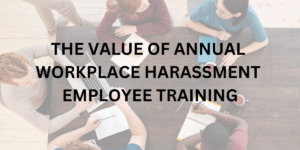Out of all the questions that I receive from business managers, the top question is about workplace harassment prevention. Workplace harassment is a pressing issue that affects employees’ well-being and organizations’ overall health. Managers and HR personnel play a pivotal role in fostering a respectful and inclusive work environment. Many practices are effective and can decrease workplace harassment. This blog will discuss three essential workplace harassment prevention tips for managers, business owners, and HR personnel, emphasizing their importance in creating a safer, more productive workplace.
(1) LEAD BY EXAMPLE
THE PREVENTION OF WORKPLACE HARASSMENT STARTS AT THE TOP!!! The behavior of managers and HR personnel sets the tone for the entire workplace. Leading by example is arguably the most critical step in preventing workplace harassment. Managers should exhibit the highest professionalism, respect, and inclusivity standards in their interactions with employees.
By demonstrating respectful behavior and adherence to company policies, managers establish a strong foundation for the entire team. Employees are more likely to follow suit when they witness their leaders consistently modeling the desired behavior. When managers treat everyone with respect, regardless of gender, race, or any other characteristic, it sends a powerful message about the organization’s commitment to fostering a harassment-free environment.
(2) CREATE A CULTURE OF OPEN COMMUNICATION
Effective communication is key to preventing workplace harassment. Managing personnel should encourage open and transparent dialogue within their teams. Here’s how:
1. Establish Trust: Foster trust among employees by actively listening to and taking their concerns seriously. Ensure employees know they can come to you with any issue and their confidentiality will be respected.
2. Regular Check-Ins: Schedule regular one-on-one check-ins with team members to gauge their well-being and satisfaction. This allows you to address any concerns or issues promptly.
3. Anonymous Reporting: Implement an anonymous reporting system that allows employees to report harassment or misconduct without fear of retaliation. Make sure this system is well-publicized and accessible to all.
4. Training and Workshops: Provide training on harassment prevention and diversity and inclusion to all employees, including managers. These programs can help create a shared understanding of acceptable behavior and the consequences of harassment. All employees should receive a minimum of 8 hours of annual training.
(3) RESPOND SWIFTLY AND EFFECTIVELY
When incidents of workplace harassment do occur, it is imperative that managers and HR personnel respond swiftly and effectively. Delayed or ineffective responses can perpetuate a culture of harassment and erode trust among employees. Here are some key steps to follow:
1. Take All Complaints Seriously: Treat every harassment complaint with utmost seriousness. Investigate all allegations promptly and thoroughly, ensuring due process for all parties involved.
2. Maintain Confidentiality: Protect the privacy and confidentiality of all parties involved in the investigation. Confidentiality is crucial to creating a safe environment for reporting.
3. Zero Tolerance: Clearly communicate the organization’s zero-tolerance policy for harassment. Employees should be aware of the consequences for those found to have committed harassment, which may include disciplinary action, up to and including termination.
4. Provide Support: Offer support to victims and witnesses of harassment. This may include access to counseling, legal advice, or additional resources. Demonstrating empathy and care for those affected can help rebuild trust within the organization.
Managers, business owners, and HR professionals play an important role in creating a workplace free from harassment. Leading by example, fostering open communication, and responding swiftly and effectively to incidents are three essential tips for managers in preventing workplace harassment. By implementing these practices, managers can contribute to a safer and more inclusive work environment, ultimately benefiting both employees and the organization. Remember, preventing workplace harassment is an ongoing process that requires dedication and commitment from all levels of an organization.
ABOUT THE AUTHOR
Alana N. Williams is a Corporate EEO Consultant and Certified EEO Investigator who specializes in increasing workplace productivity, safety, and professionalism by decreasing workplace harassment. These unsafe and illegal behaviors include a hostile working environment, sexual harassment, discrimination, and retaliation. J.A. Consultant and Training Solutions offers workplace harassment prevention and development training, confidential workplace harassment investigation, work culture assessment, and other personalized services as proven effective prevention tools.
SHRM-approved Training is OFFERED! JAIS is recognized by SHRM to offer Professional Development Credits (PDCs) for SHRM-CP® or SHRM-SCP®.
If you are an HR Professional or business manager, book a free 15-minute consultation to discuss your business needs. BOOK NOW
For more information, please visit our website at www.solutionsja.com


